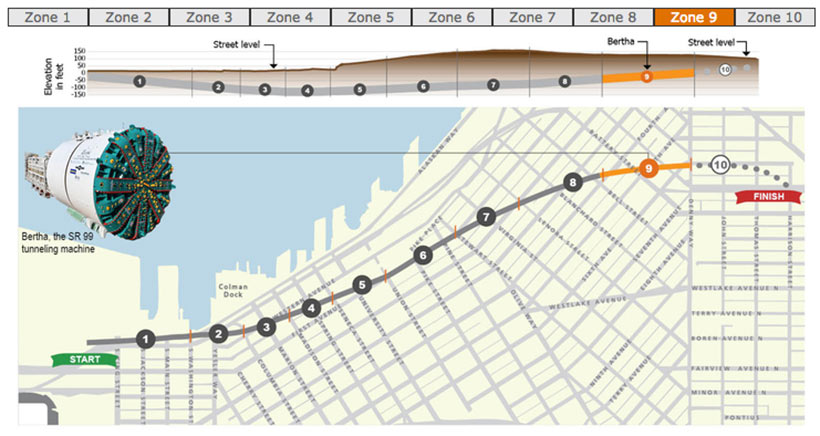Giant TBM Bertha has end in sight in Seattle 16 Feb 2017
Tunnellers on Seattle’s challenging and delayed Alaskan Way Viaduct Replacement project have been reporting good progress for some months and there is hope that the giant 17.48m diameter TBM Bertha will finally complete its double-deck urban road tunnel drive beneath the waterfront central city district by early June 2017.
An update on the fascinating project was heard last week (9 February) by a packed house at the most recent evening meeting of the British Tunnelling Society (BTS) in London. TunnelTalk attended the event, which gave an overview of the project, a review of technical challenges that have been overcome, recent progress and flashback to an area of procurement not much discussed – alternative technical concepts (ATCs).
“The machine is performing well,” reported Chris Bambridge, a Project Director - Tunnels with consulting firm Mott MacDonald, in his presentation to the strong gathering of BTS members at the ICE headquarters and held in association with the MinSouth chapter of the UK Institute of Materials, Minerals and Mining (IOM3). Mott MacDonald has been supporting the Washington State Department of Transportation (WSDOT) on the project, and Bambridge was with the project from 2009 to 2014.
The design-build contractor on the 2,850m (9270ft) long tunnel project is the Seattle Tunnel Partners (STP) JV of Dragados of Spain and Tutor Perini of the USA. The 17.48m diameter TBM on the tunnel is supplied by Hitachi Zosen of Japan.
Bambridge reported that tunnel boring was 83% complete by early February. The contractor has managed progress rates that include best day and week performances of 13 rings (27.7m) and 46 rings (98m), respectively. Although the urge is to push on, it is a steady average of 7m-8m/day being sustained.
Each precast concrete ring consists of nine 2,133mm wide x 610mm thick segments and a key. Each excavation stroke to build a 2.1m wide x 15.54m i.d. ring generates approximately 1,000 tonne of spoil.
Coming a few days after the BTS presentation, the latest progress data issued by WSDOT reported that Bertha had bored a total 7,751ft (2,385m), or 83.6%, of the tunnel by 13 February. The number of rings built is 1,184 of the total 1,426 rings required before breakthrough is reached.

Upper road deck work progressing behind the TBM
Bertha’s performance for the month to 13 February was 371ft (114.15m) and follows 593ft (182.5m) achieved for the month of January, which included a stoppage of 10 days for planned maintenance. The maintenance work involved hyperbaric access to the cutterhead to replace 300 of its 500 scrapers, undertake inspections and carry out other works.
The huge TBM was launched in mid-2013 but has had an interrupted journey reported Bambridge. These included six unplanned stoppages, the longest for about two years required to carry out extensive mechanical repairs to the machine after being lifted to the surface from an emergency rescue shaft. After repairs and enhancements to the cutterhead, drive unit and shield equipment, the machine was relaunched in early 2016. Progress has also been interrupted by five planned stoppages to date, some calling for hyperbaric interventions.
While the main problem that stopped the TBM during 2014-15 happened early in the drive, after less than five months and 1,000ft into the drive and almost near the end of the learning curve, the contractor took the opportunity to re-programme many other scheduled activities for the project is needed to replace underground the existing State highway SR99 viaduct, said Bambridge.
According to its most recently published schedule (Dec 2016, and provided by WSDOT), STP has programmed a further 2 or 3 short maintenance stops. With these included, STP anticipates a breakthrough to complete the TBM drive by late May or early June. If that is the case, the landmark US tunnelling project would achieve the milestone breakthrough just before the country’s largest annual gathering of tunnellers at 2017 services of the RETC (Rapic Excavation and Tunneling Conference) to be held in San Diego, California.
In his project update to the BTS/MinSouth meeting, Bambridge noted the forecast June date and also updated the meeting on some of the project’s other key works, such as the activities near the south and north portals which are well advanced.
The re-programmed works by STP have also involved construction of the concrete double-deck roadway within the tunnel as Bertha continues boring. The original plan was to perform the internal roadway structure work after completion of tunnel excavaton. The latest WSDOT data, to 10 February, reports that almost 4,000ft (1,230m), or 43%, of the upper road deck has been built. The lower deck has not been placed as the space remains open for service traffic and access to the advancing TBM.
Bambridge’s well-received presentation included a drone flight video down the tunnel from the south portal along and through the road deck structure, through the TBM trailing gear and up to the rear of the shield. It was a captivating addition for the audience.
References
- Half-way milestone for TBM Bertha – TunnelTalk, Oct 2016
- VIDEO: Highway construction behind TBM Bertha – TunnelTalk, November 2016
- Bertha repairs and relaunch strategy in Seattle – TunnelTalk, 22 July 2015
- SR99 tunnel budget stretched to the limit – TunnelTalk, April 2015
|
|
|
|
|
Add your comment
- Thank you for taking the time to share your thoughts and comments. You share in the wider tunnelling community, so please keep your comments smart and civil. Don't attack other readers personally, and keep your language professional.





